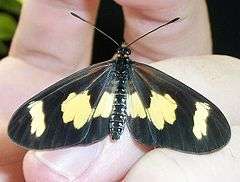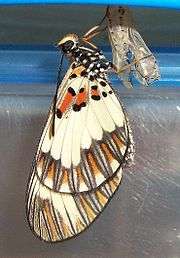Acraea cabira
| Yellow-banded Acraea |
 |
| Male Telchinia cabira |
|
| Scientific classification |
| Kingdom: |
Animalia |
| Phylum: |
Arthropoda |
| Class: |
Insecta |
| Order: |
Lepidoptera |
| Family: |
Nymphalidae |
| Tribe: |
Acraeini |
| Genus: |
Acraea |
| Species: |
A. cabira |
| Binomial name |
Acraea cabira
Hopffer, 1855 |
|
| Synonyms |
- Acraea (Actinote) cabira
- Telchinia cabira (Hopffer, 1855)
- Hyalites cabira (Hopffer, 1855)
- Acraea supponina ninapo Suffert, 1904
- Acraea apecida Oberthür, 1893
- Acraea apecida var. flavomaculata Lanz, 1896
- Acraea apecida var. natalensis Staudinger, 1896
- Acraea cabira biraca Suffert, 1904
- Acraea apecida var. abrupta Grünberg, 1910
- Acraea cabira apecida var. swinburnei Stevenson, 1940
|
The Yellow-banded Acraea (Acraea cabira) is a butterfly of the Nymphalidae family and is native to Africa.

Side view of a male Acraea cabira recently hatched from its pupa
Description
The wingspan is 38–44 mm for males and 40–45 mm for females.[1] The male and female are very similar in colour. The upper surface of the wings is near-black with large yellow patches on the fore- and hindwing. There is some reddish-brown on the veins near the base of the forewings. The underside has patches of yellow corresponding to the upperside. The base of the undersurface of the wing has orange-brown markings with black spots. The margin of the wing on the undersurface has black lines on an orange-brown background.[2]
Distribution
It is found from the eastern subtropical forest areas of South Africa, through Swaziland, Zimbabwe,[2] and to Uganda, the Congo and Kenya.
Life Cycle
Larvae
The larvae feed on Triumfetta (including Triumfetta tomentosa), Hemannia, Hibiscus and Cephalomma species. When young, they group together on a mass of silk that they spin on the foodplant, but as they grow older they venture out alone to different parts of the foodplant.
Pupae
The pupae have a whitish to yellowish background with two rows of yellow and black markings down the back, but the pupa becomes dark coloured close to hatching. The wing areas have fine black veining on a whitish to yellowish background, but the black and yellow wings show through the shell of the pupa near hatching.
Adults
Adults are on wing year round but are more common in warmer months.[1] They have a slow, weak flight pattern and stay close to the ground, favoring sunny areas in forest clearings or on the edges of forest. The adults feed on nectar from flowers.[2]
Gallery
| A mass of young larvae on the foodplant |
| Larva eating flower of Triumfetta sp. |
| Pupa viewed from the back, with shed caterpillar skin on the left |
| A female pupa viewed from the side, a few hours before hatching |
| A pair mating in captivity (female at the top of the picture) |
|
Taxonomy
Acraea cabira is a member of the Acraea bonasia species group see Acraea.
References
- 1 2 Woodhall, S. (2005). Field Guide to Butterflies of South Africa. Cape Town: Struik Publishers.
- 1 2 3 Williams, M. (1994). Butterflies of Southern Africa; A Field Guide. ISBN 1-86812-516-5.
- Bernaud & Pierre, 2007. - Acraea cabira, A. sotikensis et espèces voisines. Révision et premiers états. Lambillonea, CVII, 1bis, supplément II, Mai 2007: 1-14
External links